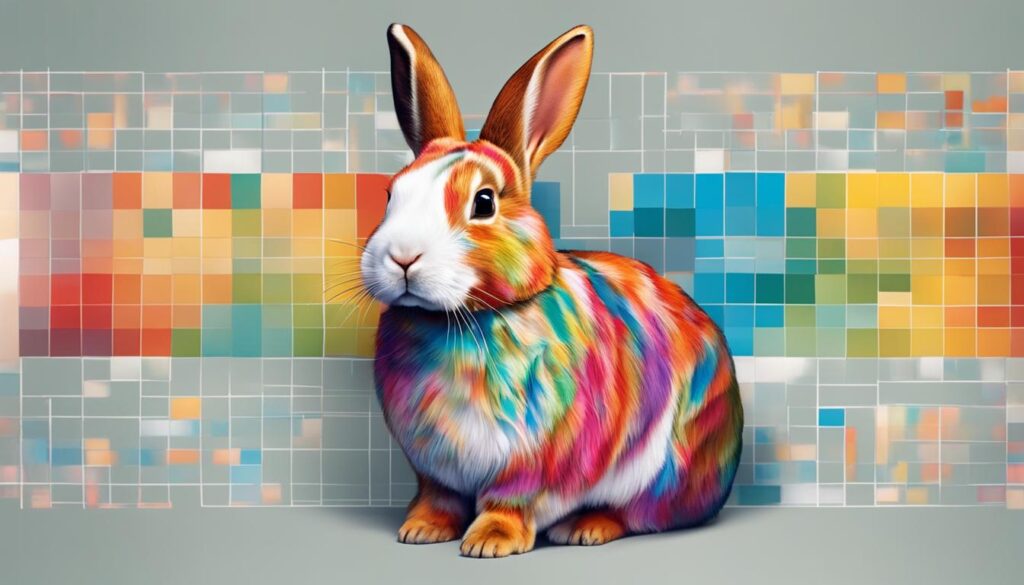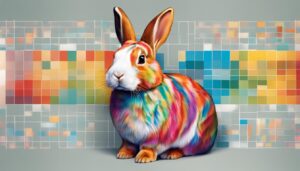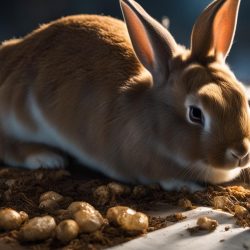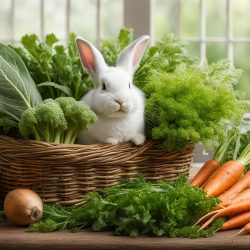Rabbits are fascinating creatures with a wide range of coat colors and unique physical traits. These traits are influenced by their genetic makeup and understanding rabbit genetics is essential for breeders looking to produce rabbits with specific traits and coat colors. In this section, we will explore the basics of rabbit genetics, including genealogy, inheritance patterns, and polygenic traits. We will also examine the factors that contribute to coat color variations in rabbits and the role of genetic diversity in rabbit breeding programs.
Key Takeaways
- Rabbit genetics plays a significant role in determining coat colors and physical traits.
- Understanding genealogy and inheritance patterns specific to rabbits is essential in breeding programs.
- Polygenic traits, influenced by multiple genes, are common in rabbit breeding and contribute to the overall phenotype of rabbits.
- Maintaining genetic diversity is crucial for the long-term health and vitality of rabbit breeds.
The Basics of Rabbit Genetics
Before delving into the intricacies of rabbit genetics, it is essential to understand the fundamental concepts of genetics. Genetics is the study of how traits, such as appearance and behavior, are passed down from one generation to the next.
Rabbits have 22 pairs of chromosomes, which carry the genetic code that determines their physical and behavioral characteristics. Each chromosome contains thousands of genes, which are segments of DNA that provide the instructions for making specific proteins that influence various traits.
Rabbit Genealogy
Rabbit genealogy refers to the study of a rabbit’s ancestry, and it plays an essential role in understanding the genetic inheritance of traits. It involves tracing a rabbit’s pedigree, which is a chart that shows the relationship between different rabbits in a breeding program and the traits that they possess.
In rabbit breeding, it is crucial to maintain accurate records of a rabbit’s pedigree to ensure that desirable traits are passed down to future generations. A thorough understanding of rabbit genealogy can help breeders identify rabbits with desirable traits and avoid those with undesirable ones.
Rabbit Genetic Inheritance
Rabbit genetic inheritance refers to the process by which traits are passed down from parent rabbits to their offspring. Traits can be inherited in different ways, depending on the type of gene involved.
There are two types of genes: dominant and recessive. Dominant genes are those that will always be expressed in the offspring, even if they only inherit one copy of the gene from one parent. Recessive genes are only expressed if the rabbit inherits two copies of the gene – one from each parent.
Rabbit genetic inheritance also involves the concept of alleles, which are different versions of a gene. Each rabbit has two alleles for each gene, one inherited from each parent.
Understanding the basics of rabbit genetics, including genealogy and genetic inheritance, is crucial for successful rabbit breeding. By analyzing a rabbit’s pedigree and understanding the inheritance patterns of specific traits, breeders can make informed decisions about which rabbits to breed to produce desired offspring.
Understanding Rabbit Coat Color Genetics
Rabbits come in a wide variety of coat colors, ranging from white to black and every shade in between. Understanding the genetic variations that influence rabbit coat color is essential for breeders looking to create specific patterns and traits in their rabbits.
Types of Rabbit Coat Color Genetics
There are two main types of genes that determine rabbit coat color: extension and agouti. The extension gene determines whether the rabbit’s color will be black or red. If the rabbit has two dominant extension genes, it will be black, while two recessive extension genes will result in a red coat. If the rabbit has one dominant and one recessive extension gene, it will be black but can carry the red gene and pass it on to its offspring.
The agouti gene controls the distribution of black and yellow pigment in the rabbit’s coat. If the rabbit has a dominant agouti gene, it will have a banded coat with black at the tips and yellow at the base. Recessive agouti genes result in a solid color coat.
Other Factors Influencing Rabbit Coat Color
While the extension and agouti genes are the primary determinants of rabbit coat color, other genetic factors can also influence color variations. These include:
- Chinchilla: a recessive gene that lightens the coat color and adds a silver sheen
- Steel: a dominant gene that darkens the coat color and gives it a bluish tint
- Tan: a dominant gene that produces a tan pattern on the belly, nose, and ears
- Broken: a recessive gene that results in a spotted or mottled coat pattern
Breeding for Specific Rabbit Coat Colors
Understanding the genetic variations that determine rabbit coat color is essential for breeders looking to create specific colors and patterns in their rabbits. By selectively breeding rabbits with desirable traits, such as a certain coat color or pattern, breeders can enhance these traits in future generations. However, it’s important to keep in mind the potential negative effects of inbreeding and to maintain genetic diversity in rabbit populations.
Traits Influenced by Genetics in Rabbits
Genetics play a significant role in determining various traits in rabbits. Breeders looking to successfully produce rabbits with specific traits must understand the importance of tracking and predicting genetic outcomes. Breeding charts are invaluable in this regard and can help breeders monitor the occurrence of genetic traits in their breeding program.
Size Traits
The size of rabbits is influenced by specific genes that control growth and development. Breeding charts can help a breeder predict the size of a rabbit by tracking the size of its parents and ancestors. By selectively breeding larger rabbits, a breeder can produce larger offspring over time. Conversely, by breeding smaller rabbits, a breeder can produce miniature breeds.
Ear Shape Traits
Rabbit ears come in various shapes and sizes, and like size traits, are controlled by specific genes. Breeders can use breeding charts to track the occurrence of different ear shapes in their breeding program. By selectively breeding rabbits with desired ear shapes, breeders can produce offspring with the desired trait.
Fur Texture Traits
The texture of rabbit fur can vary greatly and is controlled by specific genes. Breeding charts can help breeders track the occurrence of desired fur textures in their breeding program. By selectively breeding rabbits with desired fur textures, breeders can produce offspring with the desired trait.
Temperament Traits
Temperament traits in rabbits are influenced by genetics and can be important for breeders who produce rabbits for pets or for specific purposes, such as therapy rabbits. Breeding charts can help breeders track the occurrence of desired temperamental traits in their breeding program. By selectively breeding rabbits with desired temperaments, breeders can produce offspring with the desired trait.
Example Breeding Chart
| Rabbit | Size Gene | Ear Shape Gene | Fur Texture Gene | Temperament Gene |
|---|---|---|---|---|
| Parent 1 | BB | ee | FF | SS |
| Parent 2 | bb | EE | ff | ss |
| Offspring 1 | Bb | ee | Ff | Ss |
| Offspring 2 | Bb | Ee | Ff | Ss |
| Offspring 3 | bb | ee | ff | ss |
In the example breeding chart, each gene is represented by two letters, with one letter representing each parent’s gene. By following the chart, breeders can predict the occurrence of genetic traits and plan their breeding program accordingly.
Inheriting Genetic Disorders in Rabbits
Rabbits, like all living organisms, can inherit genetic disorders from their parents. These disorders can affect their health and well-being, as well as their ability to breed and produce offspring. It is important for rabbit breeders to understand how certain genetic disorders are passed down from one generation to the next in order to minimize their occurrence.
Genetic Inheritance
Genetic inheritance in rabbits follows the same basic principles as in any other organism. Each rabbit has two copies of each gene, one inherited from its mother and one from its father. If a rabbit inherits two copies of a faulty gene, it will exhibit the corresponding disorder. If a rabbit inherits only one copy of a faulty gene, it is considered a carrier and can pass the disorder on to its offspring.
Some common genetic disorders in rabbits include dental malocclusion, which causes misaligned teeth, and malocclusion of the incisors, which makes it difficult for rabbits to eat and drink. Another genetic disorder is torticollis, which causes the head to tilt to one side. Rabbits with torticollis often have difficulty maintaining their balance and may develop other health issues as a result.
Minimizing the Occurrence of Genetic Disorders
The best way to minimize the occurrence of genetic disorders in rabbit breeding is to carefully select breeding pairs. Breeders should only mate rabbits that are healthy and do not exhibit any signs of genetic disorders. They should also avoid breeding closely related rabbits, as this can increase the likelihood of inherited disorders.
Breeders can also use genetic testing to identify rabbits that are carriers of specific disorders. This can help them make informed decisions about which rabbits to breed, as well as which offspring to keep for future breeding.
Conclusion
While genetic disorders in rabbits can be inherited and have a significant impact on their health and well-being, it is possible for breeders to minimize their occurrence through careful selection and genetic testing. By understanding how these disorders are passed down from one generation to the next, breeders can make informed decisions and work towards producing healthy and genetically diverse rabbit populations.
Breeding Strategies for Desired Genetic Traits
Rabbit breeding can be a strategic process that involves careful planning to achieve specific genetic traits. By understanding the basics of rabbit genetics and coat color variations, breeders can create targeted breeding programs to enhance desired traits in their rabbits. In this section, we will explore some of the breeding strategies employed by rabbit breeders to achieve their genetic breeding goals.
Inbreeding and Linebreeding
Inbreeding and linebreeding are techniques used to concentrate the genes of a particular rabbit to enhance desirable traits. Inbreeding involves mating closely related rabbits, such as siblings or parent-offspring, to produce offspring with a uniform genetic background. Linebreeding is a similar technique that involves mating rabbits that share a common ancestor but are not as closely related as inbreeding. The goal of linebreeding is to maintain a specific bloodline and improve genetic traits.
However, inbreeding and linebreeding can also increase the risk of producing offspring with genetic disorders. Therefore, it’s essential to carefully evaluate the health and genetic history of rabbits before employing these techniques.
Crossbreeding
Crossbreeding involves mating rabbits from different breeds to create offspring with specific traits. This technique is often used to produce rabbits with unique coat colors or to enhance the overall conformation of the breed. Crossbreeding can also improve the genetic diversity of a rabbit population, reducing the risk of inbreeding-related genetic disorders.
However, crossbreeding can also result in unpredictable genetic outcomes. For example, when a rabbit has recessive genes for an undesired trait, breeding it with a rabbit from a different breed may not produce the desired outcome.
Selective Breeding
Selective breeding involves choosing rabbits with desirable traits and breeding them to produce offspring with those traits. This technique can be used to enhance specific traits, such as coat color or size, or to improve overall health and temperament. Breeders can use breeding charts and pedigree analysis to track the inheritance of specific traits and make informed breeding decisions.
However, selective breeding can also lead to a loss of genetic diversity. Therefore, it’s crucial to rotate breeding stock and avoid excessive inbreeding to preserve the genetic health of the rabbit population.
Genetic Testing
Genetic testing can be a valuable tool for rabbit breeders looking to enhance desired traits. For example, genetic testing can identify rabbits with recessive genes for specific traits, allowing breeders to avoid mating them with rabbits that also carry those genes. Genetic testing can also identify rabbits with desirable genes, allowing breeders to focus their breeding efforts on those individuals.
However, genetic testing can be expensive and time-consuming, and it may not be necessary for all breeding programs.
Conclusion
Breeding rabbits with specific traits requires a comprehensive understanding of rabbit genetics and a strategic breeding program. Breeders can employ a variety of techniques, including inbreeding, linebreeding, crossbreeding, selective breeding, and genetic testing, to achieve their desired outcomes. However, it’s crucial to carefully monitor the genetic health of the rabbit population and avoid excessive inbreeding to preserve genetic diversity.
Tools for Analyzing Rabbit Genetics
Breeders can use various tools to analyze rabbit genetics and make informed decisions for their breeding programs. These tools include pedigree analysis, genetic testing, and rabbit breeding charts.
Pedigree Analysis
Pedigree analysis allows breeders to trace the lineage of their rabbits and identify any genetic patterns. This can help breeders determine the likelihood of certain traits appearing in future offspring and make informed decisions about breeding pairs. A pedigree chart can help breeders visualize the relationships between multiple generations of rabbits.
Genetic Testing
Genetic testing can reveal specific genetic variations in rabbits that may not be visible to the naked eye. For example, a test can determine if a rabbit carries a certain gene for a particular coat color. This information can help breeders choose the right rabbits to breed for desired traits and avoid breeding pairs that could produce offspring with genetic disorders.
Rabbit Breeding Charts
Rabbit breeding charts can help breeders keep track of the traits and genetics of individual rabbits and their offspring. By recording the coat color, size, ear shape, fur texture, and temperament of each rabbit, breeders can create a family tree of genetic traits and identify successful breeding pairs. These charts can also help breeders predict the outcomes of specific breeding combinations and plan their future breeding strategies.
Genetic Manipulation and Ethical Considerations
Genetic manipulation techniques offer breeders the ability to alter rabbit genetics, either through selective breeding or genetic engineering. However, these practices raise ethical considerations for the rabbit breeding community.
Selective Breeding:
Selective breeding involves choosing rabbits with desired traits to mate with each other to produce offspring with those traits. While this is a common practice among breeders, it can potentially lead to health problems for the offspring. Inbreeding, where closely related rabbits are bred together, can increase the likelihood of genetic disorders and reduced overall health and lifespan. Breeders must be knowledgeable about the risks of selective breeding and take measures to minimize the negative effects on the rabbits.
Genetic Engineering:
Genetic engineering involves manipulating the genetic makeup of an organism to create desired traits. While this practice is not yet widespread in rabbit breeding, it is a controversial topic within the larger scientific community. Some opponents argue that genetic engineering can lead to unforeseen consequences and pose risks to biodiversity. Others argue that genetic engineering can help eliminate genetic disorders and enhance desirable traits in rabbits, supporting the continued use of the practice.
Implications for Rabbit Breeding:
The ethical considerations surrounding genetic manipulation practices have implications for the rabbit breeding community. Breeders must weigh the potential risks and benefits of these techniques and consider their impact on the health and well-being of the rabbits. Additionally, breeders must consider the impact of these practices on genetic diversity and the long-term sustainability of rabbit breeds. Overall, it is important for breeders to approach these techniques with caution and make informed decisions that prioritize the health and welfare of the rabbits.
The Role of Genetic Diversity in Rabbit Breeding
Maintaining genetic diversity is crucial for the long-term health and vitality of rabbit breeds. Rabbit genealogy helps breeders understand the genetic background of their rabbits and identify potential genetic variations.
Inbreeding, a common breeding practice, narrows the gene pool and increases the likelihood of inherited genetic disorders. Maintaining genetic diversity helps reduce the risk of these disorders.
One way to improve genetic diversity in rabbit breeding is through outcrossing, which involves breeding rabbits from different bloodlines to introduce new genetic material. Another method is line breeding, which involves breeding closely related rabbits to maintain specific traits while preserving genetic diversity.
| Benefits of Genetic Diversity in Rabbit Breeding | Consequences of Inbreeding |
|---|---|
| – Increased resistance to disease | – Increased risk of inherited genetic disorders |
| – Improved reproductive performance | – Reduced fertility and litter size |
| – Enhanced growth and body conformation | – Decreased vitality and lifespan |
In summary, genetic diversity is critical to the long-term success of rabbit breeding programs. Breeders who prioritize genetic diversity in their breeding strategies are more likely to produce healthy, genetically sound rabbits with desirable traits.
Understanding Polygenic Traits in Rabbit Breeding
Polygenic traits, also known as quantitative traits, are traits that are influenced by multiple genes rather than a single gene. Polygenic traits in rabbits include weight, body size, and ear length, and they can contribute to the overall phenotype of the rabbit.
One of the challenges of working with polygenic traits is that they can be difficult to predict and control. This is because each gene involved in the trait only has a small effect, and the interaction between multiple genes can be complex. However, by understanding the basics of polygenic inheritance, breeders can still work with these traits to produce rabbits with desired characteristics.
Understanding Polygenic Inheritance
Polygenic traits are influenced by multiple genes, and each gene contributes a small effect to the overall trait. In some cases, the effects of individual genes are additive, meaning that the more copies of a particular gene a rabbit has, the more pronounced the trait will be. In other cases, the effects of individual genes are non-additive, meaning that the interaction between multiple genes is needed to produce the trait.
For example, body weight in rabbits is a polygenic trait that is influenced by multiple genes. Each gene involved contributes a small additive effect, which can make predicting the weight of offspring challenging. However, by breeding rabbits with known weights and tracking their offspring, breeders can gain a better understanding of the genetics involved in weight determination and work towards producing rabbits with desired weights.
Working with Polygenic Traits in Rabbit Breeding
When working with polygenic traits, it’s important to consider the heritability of the trait. Heritability refers to the proportion of variation in a trait that can be attributed to genetics rather than environmental factors. Traits with high heritability are easier to predict and control through breeding.
One strategy for working with polygenic traits is to use a selection index. A selection index is a tool that combines information on multiple traits to select the best breeding candidates. By selecting breeding rabbits with the highest scores on the selection index, breeders can work towards improving multiple traits simultaneously, including polygenic traits.
Conclusion
Polygenic traits can be challenging to work with in rabbit breeding due to their complex genetic nature. However, by understanding the basics of polygenic inheritance and working with tools such as selection indexes, breeders can still produce rabbits with desired characteristics. With careful breeding and selection strategies, polygenic traits can be used to enhance the overall health, size, and appearance of rabbit breeds.
Genetic Considerations for Show Rabbits
In the world of rabbit breeding, show rabbits hold a special place. Individuals and breeders alike strive to produce rabbits that meet the specific standards set forth by various rabbit breed organizations. These standards often include certain physical characteristics, such as fur type and ear length, as well as specific coat colors and patterns. Understanding the genetic considerations involved in breeding show rabbits can help breeders produce rabbits that excel in the show ring.
One crucial aspect of breeding show rabbits is understanding the specific breed standards. For example, the American Rabbit Breeders Association has very specific standards for each breed of rabbit, including ideal weights, fur types, and ear lengths. By understanding these standards, breeders can select rabbits that are best suited for producing show-quality offspring.
Coat color and pattern are also important factors to consider when breeding show rabbits. Some breeds have specific coat colors and patterns that are preferred for show purposes. For example, showing a Siamese Satin rabbit without the signature pointed pattern would result in a disqualification. Other breeds, like the Mini Rex, have a wide variety of accepted colors and patterns. Understanding the genetics behind coat color and pattern can help breeders select rabbits that are most likely to produce offspring with the desired coat markings.
One tool that can be helpful for breeders looking to produce show rabbits is a breeding chart. By tracking the genetics of their rabbits and noting the traits and coat colors of each individual, breeders can predict the likelihood of certain traits and colors appearing in offspring. This allows them to make strategic breeding decisions to produce rabbits that meet the specific standards for their breed.
Another important factor to consider when breeding show rabbits is genetic diversity. Inbreeding or breeding rabbits with similar genetic makeup can lead to a higher risk of genetic disorders and health issues in offspring. Maintaining genetic diversity is crucial for the long-term health and vitality of rabbit breeds, including those used for show purposes.
In conclusion, breeding show rabbits involves a specific set of genetic considerations. Understanding breed standards, coat colors and patterns, breeding charts, and genetic diversity can help breeders produce rabbits that excel in the show ring. By utilizing these tools and techniques, breeders can work towards improving and preserving the quality of their chosen rabbit breeds.
Conclusion
In conclusion, understanding rabbit genetics is crucial for rabbit breeders looking to create rabbits with specific traits and coat colors. By delving into the intricacies of rabbit genetics, breeders can make informed decisions, ensure genetic diversity, and work towards the betterment of rabbit breeds.
Importance of Understanding Rabbit Genetics
Understanding rabbit genetics is essential for breeders as genes play a significant role in determining various traits in rabbits, such as size, ear shape, fur texture, and temperament. Moreover, maintaining genetic diversity is crucial for the long-term health and vitality of rabbit breeds. Therefore, understanding the underlying genetic variations that contribute to coat color patterns and polygenic traits in rabbits can help breeders make informed decisions when breeding rabbits for specific purposes.
Genetic Considerations for Breeding Show Rabbits
For breeders looking to breed show rabbits, understanding the genetic considerations for breeding show-quality rabbits is crucial. Genetics play a significant role in determining various coat color patterns and other traits that are judged in shows. Therefore, breeders must work with specific coat color patterns and ensure that they are breeding rabbits that meet breed standards.
The Future of Rabbit Genetics
The future of rabbit genetics looks promising with the emergence of new technologies such as selective breeding and genetic engineering. However, it is essential to consider the ethical implications of these practices, and their impact on the rabbit breeding community. The use of selective breeding and genetic engineering should not compromise the genetic diversity of rabbit breeds, and breeders should prioritize the long-term health and vitality of their rabbits above all else.
Overall, understanding rabbit genetics is crucial for the success of rabbit breeding programs. From coat color patterns to polygenic traits and genetic disorders, genetics plays a significant role in the overall health and vitality of rabbit breeds. By utilizing tools such as pedigree analysis, genetic testing, and breeding charts, breeders can make informed decisions and work towards the betterment of rabbit breeds.
FAQ
What is rabbit genetics?
Rabbit genetics refers to the study of how genes and genetic traits are inherited and expressed in rabbits. It focuses on understanding the various factors that influence coat color patterns, size, conformation, and other traits in rabbits.
What are the basics of rabbit genetics?
The basics of rabbit genetics involve understanding concepts such as genealogy, inheritance patterns, and how specific genes are passed down from one generation to the next. By grasping these fundamental concepts, breeders can make informed decisions in their breeding programs.
How do genetics influence coat color in rabbits?
Rabbit coat color genetics can be complex. It involves the interaction of multiple genes and genetic variations that dictate the color patterns seen in different rabbit breeds. Understanding these genetic factors is essential for rabbit breeders who want to breed specific coat colors.
What traits in rabbits are influenced by genetics?
Genetics play a significant role in determining various traits in rabbits, including size, ear shape, fur texture, and temperament. Specific genes control these traits, and understanding their inheritance patterns is important for breeders who want to produce rabbits with desired characteristics.
Can genetic disorders be inherited in rabbits?
Yes, genetic disorders can be inherited in rabbits. Certain genetic mutations or abnormalities can be passed down through generations, affecting the overall health and well-being of rabbits. Breeders should be aware of these potential genetic disorders and take steps to minimize their occurrence.
What breeding strategies can enhance desired genetic traits in rabbits?
Breeders can employ various strategies to enhance desired genetic traits in rabbits. This can include selective breeding, which involves mating rabbits with specific traits, or utilizing genetic testing to identify carriers of desirable traits. These strategies help breeders create rabbits with specific characteristics.
What tools are available for analyzing rabbit genetics?
Several tools and resources are available to analyze rabbit genetics. Pedigree analysis, genetic testing, and breeding charts are commonly used to understand the genetic makeup of rabbits, predict inheritance patterns, and make informed breeding decisions.
What are the ethical considerations of genetic manipulation in rabbit breeding?
Genetic manipulation techniques, such as selective breeding and genetic engineering, raise ethical considerations in rabbit breeding. It is important to examine and understand the potential impacts of these practices on the welfare of rabbits and the overall rabbit breeding community.
Why is genetic diversity important in rabbit breeding?
Genetic diversity is crucial for the long-term health and vitality of rabbit breeds. Maintaining a diverse gene pool helps reduce the prevalence of genetic disorders, promotes overall robustness, and allows for potential adaptation to changing environments.
What are polygenic traits in rabbit breeding?
Polygenic traits are traits influenced by multiple genes in rabbit breeding. These traits, such as body shape or fur density, are the result of the combined effects of several genes. Understanding and working with polygenic traits is important for breeders aiming to produce rabbits with specific phenotypes.
How do genetics affect show rabbits?
Genetics play a significant role in show rabbits. Breeders consider specific breed standards and coat color patterns when breeding show-quality rabbits. Understanding the genetic considerations for show rabbits helps breeders consistently produce rabbits that meet these standards and excel in the show ring.





